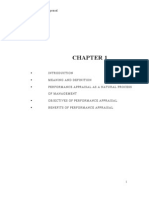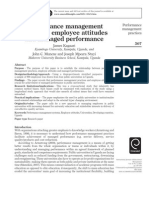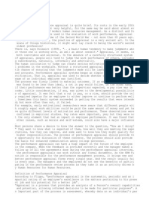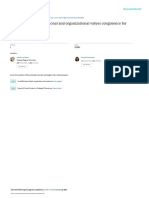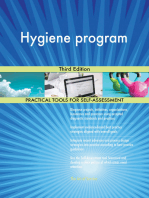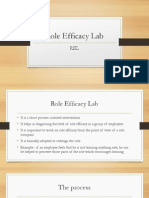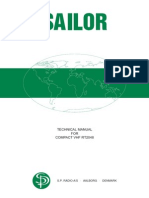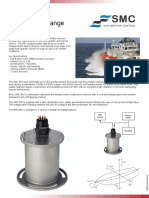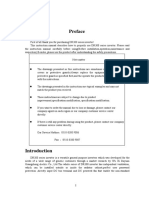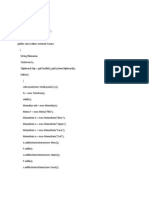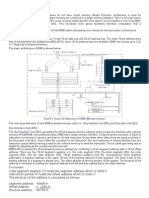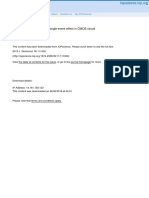Professional Documents
Culture Documents
Total Quality Management and Its Impact On Organizational Performance The Case of Ethiotelecom
Original Title
Copyright
Available Formats
Share this document
Did you find this document useful?
Is this content inappropriate?
Report this DocumentCopyright:
Available Formats
Total Quality Management and Its Impact On Organizational Performance The Case of Ethiotelecom
Copyright:
Available Formats
Volume 7, Issue 5, May – 2022 International Journal of Innovative Science and Research Technology
ISSN No:-2456-2165
Total Quality Management and its Impact on
Organizational Performance:
The Case of Ethiotelecom
Temesgen Ayenew Birhan*
*Department of Accounting and Finance,
College of Business and Economics, Bahir Dar University
Abstract:- Total Quality Management refers to a order to fill a gap in the literature and understanding about
management concept which many companies widely total quality management practice and its impact on
employed. Total quality management used by organizational performance in Ethiopia Telecom. Many
organization to acquire competitive edge in terms of researchers pointed out that quality management principles
quality, productivity, customer happiness, and might be implemented in any company and sector of the
profitability. The study's exact objectives were economy, including industry, service, education, and
determined by the researcher. The descriptive and government.Top management commitment, employee
explanatory study design, as well as the stratified sample involvement, process management, employee
approach, was used to attain the goals. It was believed empowerment, and customer focus are the most typical total
that both quantitative and qualitative research would be quality management dimensions used by firms (Jaafreh,
used. Structural equation model was used for analyzing 2008)
primary data, and secondary data was used to establish
relevant literature and make the hypothesis more II. STATEMENT OF THE PROBLEM AND
objective and sensible. The researcher comes to a RESEARCH GAP
conclusion after gathering data from ethiotelecom
employees and evaluating it in the Amos software tool. Empirical studies have shown that successful TQM
Customer focus, top management commitment, and adoption benefits organizations in a variety of ways,
employee management were the major factors for including service quality, customer satisfaction, financial
organizational performance improvement. performance, and operational performance (Irfan & Kee,
2013). As a society develops economically, culturally
Keywords:- Total quality management, structural equation matures, and educates itself, it needs higher-quality services.
model, organizational performance. As a result, a huge number of service businesses are
implementing TQM as a reaction to these difficulties today
I. INTRODUCTION (Lekhe & Mohanty, 1995).As a result, successful TQM
implementation in ethiotelecom is predicted to result in
Total Quality Management gains importance in enhanced organizational performance, which will lead to
increasing organizational efficacy and performance. Where increased customer satisfaction and productivity. However,
the business is continuously improving in each phase of no study has been undertaken on the influence of TQM on
every process, every level and every activity for the organizational performance at ethiotelecom, according to
maximizing profit at large (Chang & sun, 2007). The change researcher information from TQM websites, and the topic is
is a continuous and steady process for every organization. still unexplored. Furthermore, despite the fact that the
There are various practices, such as Quality circles, kaizen, service sector has increasingly dominated the global
TQM, etc. in developed and developing countries. Industrial economy in recent decades, the majority of research has
companies need to ensure their success and competitiveness focused on the manufacturing sector.There were still few
by using appropriate quality management practices. An TQM studies in the service sector (Al-Sabi & Samat, N,
organization's quality practices are defined as the actions 2016), indicating that additional TQM research is needed in
and procedures taken by a company or organization to the service industry.
ensure the delivery of a high-quality service or product.
The lack of literature also contributes to a lack of
Managers strive to improve organizational understanding of TQM's impact on organizational
performance through practices that are visible components performance. As a result, this study will undoubtedly
of quality management improvements (Ahmed & Hassan, contribute to the field of service quality management.Many
2003).Because there is evidence that successful studies only measure performance in financial terms, such as
implementation of TQM benefits organizations by market share value, return on investment, and profit (e.g.
improving organizational performance, it is critical to Nicolau and Sellers, 2010; Corderand Goni, 201; Easton and
investigate the impact of total quality management on Jarrel, 1998). Non-financial outcomes such as customer
ethiotelecom organizational performance in order to satisfaction, process improvement, and employee
incorporate TQM as a method for improving service satisfaction are not taken into account. Empirical studies
failures. As a result, the purpose of this study was to yield contradictory results. Significant research, for
investigate the impact of TQM on corporate performance in example, provides empirical evidence that there is a positive
IJISRT22MAY1353 www.ijisrt.com 1724
Volume 7, Issue 5, May – 2022 International Journal of Innovative Science and Research Technology
ISSN No:-2456-2165
relationship between TQM implementation and IV. RESEARCH HYPOTHESES
organizational performance (Bou-Llusar et al. 2009; Tari,
Molina and Castejon 2007; Kaynak, 2003; Douglas and The following hypothesis was developed for
Judge, 2001; Easton and Jarrel, 1998). Many studies, on the investigation in accordance with the broad purpose
other hand, show a weak or no relationship between TQM statement. The study's hypothesis is based on a theoretical
practices and organizationalperformance in ethiotelecom. concept concerning the total quality management and its
impact on organizational performance in Ethiotelecom. As a
III. RESEARCH OBJECTIVES result, four hypotheses were proposed as follows.
Ha: There was a significant effect of Top Management
The specific objectives of the study included: Commitment on organizational performance in
To determine the impact of customer focus practice on Ethiotelecom.
organizational performance in Ethiotelecom. Hb: There was a significant effect of Customer Focus
To determine the impact of top management commitment practice on organizational performance in Ethiotelecom.
on organizational performance in Ethiotelecom. Hc: There was a significant effect of Continuous
To assess the effect of continuous improvement on Improvement on organizational performance in
organizational performance in Ethiotelecom. Ethiotelecom.
To examine the effect of employee management on Hd: There was a significant effect of employee’s
organizational performance in Ethiotelecom. management on organizational performance in
Ethiotelecom.
V. CONCEPTUAL FRAMEWORK
Taking into account the many characteristics of quality management methods and organizational performance measurement
offered by a number of researchers. Customer Focus, Top Management Commitment, Continuous Improvements, and Employee
Management were the four elements of quality management methods that the researcher used in his research.
Top management Customer focus
commitment
Organizational
performance Continuous
Employee’s management improvement
Fig. 1
VI. RESEARCH METHODOLOGY Because in stratified sampling no significant groups is left
unrepresented and it saves cost and time of data collection
A. Research approach since the sample is less (Schutt, 2011).
The study's goal is to determine the impact of total
quality management approaches on Ethiotelecom C. Data inquiry
organizational performance. Because the researcher uses Both primary and secondary data used for collected data.
both descriptive and explanatory research designs, the Primary data is information gathered through techniques
mixed method would have been suggested for this study. such as interviews, questionnaires, and others. Secondary
This strategy was based on rational values, truths, and data, on the other hand, refers to previously organized
validity, with a sole focus on facts as measured empirically documents. However, in this study, the researcher gathered
on variables by quantitative methods such as surveys and data by creating questionnaires on major variables.
statistical analysis of the data (Thorpe & Jackson, 2008).
D. Method of data analysis
B. Target population and sampling Data analysis may be classified as descriptive or
This study's target population consists of Ethiotelecom inferential analysis. Even if this research uses some portion
employees. The number of employees was observable, and of descriptive analysis, inferential analysis can be widely
it included officials from the regional office.By used to make data analysis and infer from collected data. For
usingSolvin’s formula 252 samples had taken from total studied the impact of total quality management on
population.The study used stratified sampling techniques. organizational performance, the structural equation model
IJISRT22MAY1353 www.ijisrt.com 1725
Volume 7, Issue 5, May – 2022 International Journal of Innovative Science and Research Technology
ISSN No:-2456-2165
would be used (SEM). SEM has recently emerged as a variables. The latent variables cannot be directly measured.
prominent statistical method due to its ability to account for To be represented, the latent variable must be defined in
multiple variables. Variables that are observed are also terms of observed variables. The latent variables defined by
known as indicator variables or manifest variables. other observed variable were organizational performance.
Unobserved variables or factors are also referred to as latent
VII. DATA RELIABILITY
For the four independent variablesconstructs, a total of 33 items and dependent variables with four items are tested.
Reliability test
Variables No. of items Cronbach alpha Status
Independent variables
Top management commitment 7 0.777 Good
Customer focus 7 0.793 Good
Continuous Improvement 7 0.837 Great
Employees management 8 0.883 Great
Dependent Variables
Organizational performance 4 0.762 Good
Table 1
VIII. DATA VALIDITY
Hair et al. (2010)it is validitywhich indicates the degree measures of constructs should converge or share a high proportion
of variance. Composite Reliability (CR), Average Variance Extracted (AVE), and factor loading were used to assess this validity.
Convergent validity TMC CF CIM EM OP FP
AVE=∑(Xi2/N) 0.52 0.56 0.64 0.58 0.51 0.53
CR= ∑(Xi2 /(∑(Xi2 +∑δ) 0.87 0.75 0.83 0.79 0.73 0.77
Validity, AVE>0.5 and CR>0.7 Maintained Established Maintained Established Established Established
Table 2
Discriminant Validity is maintained when average variance extracted is greater than squared correlation estimates between
constructs. Significant level of discriminant validity was established as AVE > than the squared correlation estimate for all the
constructs. Show the following table.
Discriminant validity Factor correlation(r) Correlation Squared(r2) AVE>r2 Discriminant validity
TMC↔CF -0.030 0.0009 0.63 Established
TMC↔CI -0.023 0.003 0.63 Established
TMC↔EM -0.085 0.007 0.63 Established
CF↔CI 0.011 0.0001 0.63 Established
CF↔EM -0.319 0.102 0.63 Established
CI↔EM 0.12 0.0144 0.63 Established
Table 3
IX. CONFIRMATORY FACTOR ANALYSIS following table, basic indices meet the minimum criteria for
confirmatory analysis.
When the initial hypothesized model was determined
not to be the best fitting model, the model needed to be re-
specified (Kline, 2005; Meyer et al., 2006). Modification
indices were examined to re-specify the model in terms of
either trimming or building the model empirically and
theoretically. Once the model was modified, the alternative
hypothesized model would be tested using the same CFA
procedures as the above described to determine the best
fitting model to the observed dataset.
After confirming the validity of the CFA, it is time to
test the structural model, which will empirically identify the
relationships between the factors. As shown from the
IJISRT22MAY1353 www.ijisrt.com 1726
Volume 7, Issue 5, May – 2022 International Journal of Innovative Science and Research Technology
ISSN No:-2456-2165
Indices Default model Suggested criteria
RMSEA 0.074 <0.08
PCLOSE 0.000 <0.05
X2 /df 2.99 Between 1 and 5
P value 0.000 <=0.001
CFI 0.875 Approach to 0.9
IFI 0.922 Close to 0.9
TLI 0.894 Near to 0.9
Table 4
X. HYPOTHESIS TESTING USING STRUCTURAL EQUATION MODEL
Following that, this study considered analyzing the path significant of each relationship, where it examined the standardized
estimate (S.E), critical ratios (C.R), and p-value for each proposed relationship. A relationship is considered significant if the t-
value is greater than 1.96 and the p-value is less than.05).
Hypotheses Variables Estimates S.E. C.R P Status Outcome
Ha OP --TM 0.128 0.065 1.969 0.030 Significant Accept
Hb OP--CUF 0.139 0.064 2.194 0.028 Significant Accept
Hc OP--CIM 0.16 0.072 2.212 0.022 Significant Accept
Hd OP--EPM 0.005 0.048 0.113 0.910 Insignificant Reject
Table 5
XI. RESEARCH CONCLUSION should mainly focus upon designing an organizational
culture that supports TQM implementation.
The research tried to show ethiotelecom employees
perception towards the effect of total quality management REFERENCES
practice on organizational performance. Having the
information from the data analysis in the above the [1.] Ahmed, & Hassan. (2003). Survey and case
researcher finally drawn the following conclusions/findings. investigation on application of quality management
Based on study result,the researcher concluded that tools and techinques. International of quality and
customer focus has the highest impact on organizational reliability management , 795-826.
performance. [2.] Al-Sabi, & Samat,N. (2006). TQM practice service
The results also have shown that CUF is significantly quality and marketing orientation; some emparical
affecting Organizational Performance. Systematic analysis evidence from adeveloping country. management
of customer feedback and its use in the product or process research news, 713-728.
improvement, and developing customer-oriented strategies [3.] Chang, & sun. (2007). Exploring the corrsponding
can improve OP. Furthermore, design, development and between total quality management and peter senges
delivery of products according to the requirements of discipline of learning organization. journal of taiwan,
customers can also improve the organizational 807-822.
performance. [4.] Evangelos, psomas, Anagelos, Dimitros, &
The findings have also been found that EPM for TQM Kafetzopoulos. (2013). The impact of ISO 9001
practices that much not significantly affects effectiveness on the performance of service companies.
Organizational Performance, However, previous Intenational journal of quality management , 149-164.
researchers stated that effective training, good health and [5.] Irfan, S., & Kee,D.H. (2013). Critical success factor of
safety practices, and treating workers as a valuable TQM and its impact on service quality. Middle-East
resource can increases the firm performance. Journal of scientific research, 61-74.
In has been also found that CIM for TQM practices is has [6.] Jaafreh, Ali, & Abdulfetah. (2013). The effect of TQM
significant effect on Organizational performance. Effective practice on organizational performancein jordan.
Continuous improvement is critical factor to the success of International journal of finance research.
quality improvement programs. Planning for improvement [7.] Kline, R. B. (2005). Principles and practices of
of all its products and processes, frequent inspection of structural equation modeling. New York: Guilford
product quality and process, and control and improvement Press.
of processes can improve the organizational performance. [8.] Lekhe, R., & Mohanty,r.p. (1995). understanding TQM
in service system. International Journal of quality &
The results of this study also indicate TQM has a
reliability mgt, 139-153.
significant effect on organizational performance. These
results support the argument of TQM exponents that [9.] Martinez, Dewhurst, & Dale. (1998). Total quality
companies can attain better results by implementing the management origin and evolution of terms. TQM
TQM practices. The success of any TQM strategy relies Megazin, 378-386.
on leadership style of businessman, senior managers, who [10.] Prajogo, & McDermott. (2005). The relationship
between TQM practice and organizational culture.
IJISRT22MAY1353 www.ijisrt.com 1727
Volume 7, Issue 5, May – 2022 International Journal of Innovative Science and Research Technology
ISSN No:-2456-2165
International Journal of operation and production mgt,
1101-1122.
[11.] prajogo, & Sohal. (2003). The relationship between
TQM practice, quality performance,innovation
performance. international journal of quality and
reliability management, 901-918.
[12.] Schutt, r. (2011). Investigation the social world;the
process amd practice of research. Sage publication.
[13.] Sureshchandar, G., Rajendran,C, & Anantharaman.
(2001). A conceptual model for total quality
management in service organization . total quality
management, 343-363.
[14.] Talib, F., & Rahman,Z. (2010). Critical success factor
of TQM in service organization. services marketing
quarterly, 363-380.
[15.] York.k.m, & Miree. (2004). Causation or covaration:an
empirical re-examination of the link between TQM and
finance performance. Jouranl of operation
management, 294-311.
[16.] Yusuf, Gunasekaran, & Dan,g,. (2007).
Implementation of TQM in chinaand organizational
performance. TQM, 509-530.
[17.] Zhang, Z. (2000). Development model of total quality
management method and evaluating their effect on
business performance . Total quality management,
129-137.
IJISRT22MAY1353 www.ijisrt.com 1728
You might also like
- Performance Appraisal SystemDocument52 pagesPerformance Appraisal SystemManoj SahuNo ratings yet
- Effect of Employee Performance On Organizational Commitment, Transformational Leadership and Job Satisfaction in Banking Sector of MalaysiaDocument9 pagesEffect of Employee Performance On Organizational Commitment, Transformational Leadership and Job Satisfaction in Banking Sector of MalaysiaInternational Journal of Innovative Science and Research TechnologyNo ratings yet
- Bachelor of Business Administration: Project Submitted in Partial Fulfillment For The Award of DegreeDocument55 pagesBachelor of Business Administration: Project Submitted in Partial Fulfillment For The Award of DegreeHitesh RawatNo ratings yet
- Performance ApprisalDocument101 pagesPerformance Apprisalchiragjoshi100% (3)
- Applying Balanced Scorecards at Essar Telecom KenyaDocument10 pagesApplying Balanced Scorecards at Essar Telecom KenyaGaurav ThaparNo ratings yet
- Need For Sustainable Development in Policy Making For Job Satisfaction Level of Lecturers Working in Private Universities and CollegesDocument7 pagesNeed For Sustainable Development in Policy Making For Job Satisfaction Level of Lecturers Working in Private Universities and CollegesDr Anuj WilliamsNo ratings yet
- Human Resource Practices For Teaching Personnel of Selected Private Asian Higher Educational InstitutionDocument10 pagesHuman Resource Practices For Teaching Personnel of Selected Private Asian Higher Educational InstitutionGlobal Research and Development ServicesNo ratings yet
- Project Title: A Study On Effectiveness of Performance Appraisal System With Reference To Apollo Tyres Pvt. LTD., PerambraDocument11 pagesProject Title: A Study On Effectiveness of Performance Appraisal System With Reference To Apollo Tyres Pvt. LTD., Perambraathira vsNo ratings yet
- The International Journal of Human Resource ManagementDocument33 pagesThe International Journal of Human Resource ManagementAhmar ChNo ratings yet
- 2013 - Leadership and Risk-Taking Propensity Among Entrepreneurs in MsiaDocument9 pages2013 - Leadership and Risk-Taking Propensity Among Entrepreneurs in MsiajajaikamaruddinNo ratings yet
- PARUL UNIVERSITY - HUMAN RESOURCE MANAGEMENT SYLLABUSDocument3 pagesPARUL UNIVERSITY - HUMAN RESOURCE MANAGEMENT SYLLABUSVamshi ValasaNo ratings yet
- 1.6challenges and Opportunity For Organization Behaviour 1Document13 pages1.6challenges and Opportunity For Organization Behaviour 1Balakrishna Nalawade N0% (1)
- Worklife Balance and Organizational Commitment of Generation y EmployeesDocument337 pagesWorklife Balance and Organizational Commitment of Generation y Employeeseric_darryl_lim100% (4)
- Performance Management Practices, Employee Attitudes and Managed PerformanceDocument24 pagesPerformance Management Practices, Employee Attitudes and Managed PerformanceMuhammad Naeem100% (1)
- Summer Internship Project Report On Performance AppraisalDocument24 pagesSummer Internship Project Report On Performance AppraisalROSHI1988100% (1)
- QUESTIONNAIRE of Personal and Organizational Values Congruence For Employee (Q-POVC)Document7 pagesQUESTIONNAIRE of Personal and Organizational Values Congruence For Employee (Q-POVC)Farri RaufNo ratings yet
- Sip Report Nalco PDFDocument60 pagesSip Report Nalco PDFSubhashree PandaNo ratings yet
- Virtual team The Ultimate Step-By-Step GuideFrom EverandVirtual team The Ultimate Step-By-Step GuideRating: 2 out of 5 stars2/5 (1)
- Management Case Study - Module 7 - IPM Sri LankaDocument15 pagesManagement Case Study - Module 7 - IPM Sri LankaShan Anjana Jayasinghe100% (1)
- Effect of Employee Involvement On Job Performance in The Medical Research Industry in KenyaDocument22 pagesEffect of Employee Involvement On Job Performance in The Medical Research Industry in Kenyaface2faceNo ratings yet
- JDS by HackmanDocument88 pagesJDS by HackmanHY LohNo ratings yet
- DEPED RPMS Form - For Teachers - 1Document11 pagesDEPED RPMS Form - For Teachers - 1Sen AquinoNo ratings yet
- A Case Study On HR Practices in FMCG SectorDocument5 pagesA Case Study On HR Practices in FMCG SectorAnonymous CwJeBCAXpNo ratings yet
- The Effect Of Promotion And Compensation Toward Working Productivity Through Job Satisfaction And Working Motivation Of Employees In The Department Of Water And Mineral Resources Energy North Aceh DistrictDocument8 pagesThe Effect Of Promotion And Compensation Toward Working Productivity Through Job Satisfaction And Working Motivation Of Employees In The Department Of Water And Mineral Resources Energy North Aceh DistrictinventionjournalsNo ratings yet
- Research Proposal: Research Report On "Performance Evaluation"Document86 pagesResearch Proposal: Research Report On "Performance Evaluation"Nagunuri SrinivasNo ratings yet
- 206 ER NotesDocument126 pages206 ER NotesAvinash RathodNo ratings yet
- Performance Appraisal Methods and TechniquesDocument33 pagesPerformance Appraisal Methods and TechniquesSara taskeenaNo ratings yet
- Internship Format Mba HRM - LatestDocument3 pagesInternship Format Mba HRM - LatestSadia ShahzadiNo ratings yet
- Tata Mutual Fund 2Document14 pagesTata Mutual Fund 2mahesh2037100% (1)
- Employee Selection TestsDocument4 pagesEmployee Selection TestsNoman QureshiNo ratings yet
- Performance Appraisal FrameworkDocument8 pagesPerformance Appraisal Frameworktinkling111No ratings yet
- Steel Authority of India Limited Performance AppraisalDocument36 pagesSteel Authority of India Limited Performance AppraisalShveta Kaushal100% (1)
- Factors Determining Job Satisfaction of Early Childhood TeachersDocument6 pagesFactors Determining Job Satisfaction of Early Childhood TeachersHafsaNo ratings yet
- Project CHAPTER3Document28 pagesProject CHAPTER3sailaja sasiNo ratings yet
- Impact of Talent Management and EmployeeDocument6 pagesImpact of Talent Management and EmployeeMunarohNo ratings yet
- TQM in Commercial BankDocument4 pagesTQM in Commercial BankSohel Rana100% (1)
- Questionnaire On Performance Appraisal-2Document5 pagesQuestionnaire On Performance Appraisal-2Sahana ChinnakotlaNo ratings yet
- SNGPLDocument43 pagesSNGPLRoshan Zamir100% (2)
- A Research Paper On "Study of Employee's Performance Appraisal System"Document6 pagesA Research Paper On "Study of Employee's Performance Appraisal System"Anonymous CwJeBCAXpNo ratings yet
- Research Paper On Grievance of EmployeesDocument11 pagesResearch Paper On Grievance of EmployeespriyashammuNo ratings yet
- HRM and Performance: Achievements and ChallengesFrom EverandHRM and Performance: Achievements and ChallengesDavid E GuestNo ratings yet
- A Tale of Two Managers.Document4 pagesA Tale of Two Managers.Ashish ParidaNo ratings yet
- PERFORMANCE REVIEW TIPSDocument10 pagesPERFORMANCE REVIEW TIPSJagat PatelNo ratings yet
- Mahesh Questionnaire HR'2222Document3 pagesMahesh Questionnaire HR'2222Appu SpecialNo ratings yet
- Role Efficacy LabDocument5 pagesRole Efficacy LabJyoti DaveNo ratings yet
- Termination and Lay-Off BenefitsDocument3 pagesTermination and Lay-Off BenefitsMohamed ElsaiedNo ratings yet
- Importance of Effective RecruitmentDocument11 pagesImportance of Effective RecruitmentMohamed LisaamNo ratings yet
- Supervisory Management: The University of The West Indies Jamaica EasternDocument1 pageSupervisory Management: The University of The West Indies Jamaica EasternNickesha TaylorNo ratings yet
- Measuring Performance & Managing ResultsDocument4 pagesMeasuring Performance & Managing ResultsParveen MaanNo ratings yet
- Importance of Employee Retention in TheDocument3 pagesImportance of Employee Retention in Theavinash raoNo ratings yet
- HRM AssignmentDocument7 pagesHRM AssignmentEsrat Sultana EshaNo ratings yet
- ADocument9 pagesANanda Deberry WNo ratings yet
- Managerial CompetenciesDocument2 pagesManagerial Competenciesrti1957No ratings yet
- Employee Recognition and Reward PolicyDocument3 pagesEmployee Recognition and Reward PolicyRevathi RevanurNo ratings yet
- Diabetic Retinopathy Stage Detection Using CNN and Inception V3Document9 pagesDiabetic Retinopathy Stage Detection Using CNN and Inception V3International Journal of Innovative Science and Research TechnologyNo ratings yet
- Exploring the Molecular Docking Interactions between the Polyherbal Formulation Ibadhychooranam and Human Aldose Reductase Enzyme as a Novel Approach for Investigating its Potential Efficacy in Management of CataractDocument7 pagesExploring the Molecular Docking Interactions between the Polyherbal Formulation Ibadhychooranam and Human Aldose Reductase Enzyme as a Novel Approach for Investigating its Potential Efficacy in Management of CataractInternational Journal of Innovative Science and Research TechnologyNo ratings yet
- Investigating Factors Influencing Employee Absenteeism: A Case Study of Secondary Schools in MuscatDocument16 pagesInvestigating Factors Influencing Employee Absenteeism: A Case Study of Secondary Schools in MuscatInternational Journal of Innovative Science and Research TechnologyNo ratings yet
- An Analysis on Mental Health Issues among IndividualsDocument6 pagesAn Analysis on Mental Health Issues among IndividualsInternational Journal of Innovative Science and Research TechnologyNo ratings yet
- Harnessing Open Innovation for Translating Global Languages into Indian LanuagesDocument7 pagesHarnessing Open Innovation for Translating Global Languages into Indian LanuagesInternational Journal of Innovative Science and Research TechnologyNo ratings yet
- The Utilization of Date Palm (Phoenix dactylifera) Leaf Fiber as a Main Component in Making an Improvised Water FilterDocument11 pagesThe Utilization of Date Palm (Phoenix dactylifera) Leaf Fiber as a Main Component in Making an Improvised Water FilterInternational Journal of Innovative Science and Research TechnologyNo ratings yet
- Advancing Healthcare Predictions: Harnessing Machine Learning for Accurate Health Index PrognosisDocument8 pagesAdvancing Healthcare Predictions: Harnessing Machine Learning for Accurate Health Index PrognosisInternational Journal of Innovative Science and Research TechnologyNo ratings yet
- The Relationship between Teacher Reflective Practice and Students Engagement in the Public Elementary SchoolDocument31 pagesThe Relationship between Teacher Reflective Practice and Students Engagement in the Public Elementary SchoolInternational Journal of Innovative Science and Research TechnologyNo ratings yet
- The Making of Object Recognition Eyeglasses for the Visually Impaired using Image AIDocument6 pagesThe Making of Object Recognition Eyeglasses for the Visually Impaired using Image AIInternational Journal of Innovative Science and Research TechnologyNo ratings yet
- Design, Development and Evaluation of Methi-Shikakai Herbal ShampooDocument8 pagesDesign, Development and Evaluation of Methi-Shikakai Herbal ShampooInternational Journal of Innovative Science and Research Technology100% (3)
- Dense Wavelength Division Multiplexing (DWDM) in IT Networks: A Leap Beyond Synchronous Digital Hierarchy (SDH)Document2 pagesDense Wavelength Division Multiplexing (DWDM) in IT Networks: A Leap Beyond Synchronous Digital Hierarchy (SDH)International Journal of Innovative Science and Research TechnologyNo ratings yet
- Terracing as an Old-Style Scheme of Soil Water Preservation in Djingliya-Mandara Mountains- CameroonDocument14 pagesTerracing as an Old-Style Scheme of Soil Water Preservation in Djingliya-Mandara Mountains- CameroonInternational Journal of Innovative Science and Research TechnologyNo ratings yet
- The Impact of Digital Marketing Dimensions on Customer SatisfactionDocument6 pagesThe Impact of Digital Marketing Dimensions on Customer SatisfactionInternational Journal of Innovative Science and Research TechnologyNo ratings yet
- Formulation and Evaluation of Poly Herbal Body ScrubDocument6 pagesFormulation and Evaluation of Poly Herbal Body ScrubInternational Journal of Innovative Science and Research TechnologyNo ratings yet
- Electro-Optics Properties of Intact Cocoa Beans based on Near Infrared TechnologyDocument7 pagesElectro-Optics Properties of Intact Cocoa Beans based on Near Infrared TechnologyInternational Journal of Innovative Science and Research TechnologyNo ratings yet
- Comparatively Design and Analyze Elevated Rectangular Water Reservoir with and without Bracing for Different Stagging HeightDocument4 pagesComparatively Design and Analyze Elevated Rectangular Water Reservoir with and without Bracing for Different Stagging HeightInternational Journal of Innovative Science and Research TechnologyNo ratings yet
- Auto Encoder Driven Hybrid Pipelines for Image Deblurring using NAFNETDocument6 pagesAuto Encoder Driven Hybrid Pipelines for Image Deblurring using NAFNETInternational Journal of Innovative Science and Research TechnologyNo ratings yet
- Review of Biomechanics in Footwear Design and Development: An Exploration of Key Concepts and InnovationsDocument5 pagesReview of Biomechanics in Footwear Design and Development: An Exploration of Key Concepts and InnovationsInternational Journal of Innovative Science and Research TechnologyNo ratings yet
- A Survey of the Plastic Waste used in Paving BlocksDocument4 pagesA Survey of the Plastic Waste used in Paving BlocksInternational Journal of Innovative Science and Research TechnologyNo ratings yet
- Hepatic Portovenous Gas in a Young MaleDocument2 pagesHepatic Portovenous Gas in a Young MaleInternational Journal of Innovative Science and Research TechnologyNo ratings yet
- Explorning the Role of Machine Learning in Enhancing Cloud SecurityDocument5 pagesExplorning the Role of Machine Learning in Enhancing Cloud SecurityInternational Journal of Innovative Science and Research TechnologyNo ratings yet
- Cyberbullying: Legal and Ethical Implications, Challenges and Opportunities for Policy DevelopmentDocument7 pagesCyberbullying: Legal and Ethical Implications, Challenges and Opportunities for Policy DevelopmentInternational Journal of Innovative Science and Research TechnologyNo ratings yet
- Automatic Power Factor ControllerDocument4 pagesAutomatic Power Factor ControllerInternational Journal of Innovative Science and Research TechnologyNo ratings yet
- Navigating Digitalization: AHP Insights for SMEs' Strategic TransformationDocument11 pagesNavigating Digitalization: AHP Insights for SMEs' Strategic TransformationInternational Journal of Innovative Science and Research TechnologyNo ratings yet
- Studying the Situation and Proposing Some Basic Solutions to Improve Psychological Harmony Between Managerial Staff and Students of Medical Universities in Hanoi AreaDocument5 pagesStudying the Situation and Proposing Some Basic Solutions to Improve Psychological Harmony Between Managerial Staff and Students of Medical Universities in Hanoi AreaInternational Journal of Innovative Science and Research TechnologyNo ratings yet
- Mobile Distractions among Adolescents: Impact on Learning in the Aftermath of COVID-19 in IndiaDocument2 pagesMobile Distractions among Adolescents: Impact on Learning in the Aftermath of COVID-19 in IndiaInternational Journal of Innovative Science and Research TechnologyNo ratings yet
- A Review: Pink Eye Outbreak in IndiaDocument3 pagesA Review: Pink Eye Outbreak in IndiaInternational Journal of Innovative Science and Research TechnologyNo ratings yet
- Drug Dosage Control System Using Reinforcement LearningDocument8 pagesDrug Dosage Control System Using Reinforcement LearningInternational Journal of Innovative Science and Research TechnologyNo ratings yet
- The Effect of Time Variables as Predictors of Senior Secondary School Students' Mathematical Performance Department of Mathematics Education Freetown PolytechnicDocument7 pagesThe Effect of Time Variables as Predictors of Senior Secondary School Students' Mathematical Performance Department of Mathematics Education Freetown PolytechnicInternational Journal of Innovative Science and Research TechnologyNo ratings yet
- Formation of New Technology in Automated Highway System in Peripheral HighwayDocument6 pagesFormation of New Technology in Automated Highway System in Peripheral HighwayInternational Journal of Innovative Science and Research TechnologyNo ratings yet
- Manual de Servicio 66DX35G1IDocument8 pagesManual de Servicio 66DX35G1IcesarNo ratings yet
- MTH302 - Business Mathematics & Statistics - Solved - MID Term Paper - 05Document5 pagesMTH302 - Business Mathematics & Statistics - Solved - MID Term Paper - 05ehtasham shakeelNo ratings yet
- Kingfisher Rtu Mod BusDocument4 pagesKingfisher Rtu Mod BusClifford RyanNo ratings yet
- Oracle PLSQL Interview AdvDocument25 pagesOracle PLSQL Interview AdvZainul AbdeenNo ratings yet
- 3rd-grading-physics-2022-summative-quizDocument2 pages3rd-grading-physics-2022-summative-quizOdessa SantosNo ratings yet
- 2017-2018 New CatalogueDocument218 pages2017-2018 New CataloguerobmndzNo ratings yet
- Features Supported by The Editions of SQL Server 2012Document25 pagesFeatures Supported by The Editions of SQL Server 2012Sinoj AsNo ratings yet
- Chemistry Webquest Introduction to AtomsDocument3 pagesChemistry Webquest Introduction to AtomsMarx GomesNo ratings yet
- Molecular Cell Biology 7Th Edition Lodish Test Bank Full Chapter PDFDocument29 pagesMolecular Cell Biology 7Th Edition Lodish Test Bank Full Chapter PDFrorybridgetewe100% (11)
- Field Installation HandbookDocument88 pagesField Installation HandbookRamiro RamirezNo ratings yet
- Sailor Rt2048Document94 pagesSailor Rt2048Belha Lozano SanchezNo ratings yet
- End of Year Project ExamplesDocument10 pagesEnd of Year Project ExamplesMalik Fahad YounasNo ratings yet
- Adapt Formula SheetDocument6 pagesAdapt Formula SheetUngoliant101No ratings yet
- D77003 enDocument57 pagesD77003 enzliangNo ratings yet
- CFM56Document5 pagesCFM56Anonymous wkL8YVBENo ratings yet
- SMC Imu Data Sheet Motion SensorDocument2 pagesSMC Imu Data Sheet Motion SensorErwin ArdiasNo ratings yet
- Inverter DR-300 Manual PDFDocument164 pagesInverter DR-300 Manual PDFPham Khanh67% (6)
- 124 KW 166 HP at 2000 RPM: Net HorsepowerDocument12 pages124 KW 166 HP at 2000 RPM: Net HorsepowerAwanNo ratings yet
- Final Thesis On CNCDocument55 pagesFinal Thesis On CNCFranco100% (1)
- Manual Imo Pump 3g SeriesDocument8 pagesManual Imo Pump 3g SeriesВладимир50% (2)
- UsxrefDocument57 pagesUsxrefgmawoyoNo ratings yet
- TM841S-L, TM861S-L: TO-220F 8A TriacDocument2 pagesTM841S-L, TM861S-L: TO-220F 8A TriacEulerMartinsDeMelloNo ratings yet
- NotepadDocument9 pagesNotepadteenapalNo ratings yet
- Internal Architecture 8086Document3 pagesInternal Architecture 8086firoz83% (6)
- Modeling and Simulation of Single-Event Effect in CMOS CircuitDocument11 pagesModeling and Simulation of Single-Event Effect in CMOS CircuitSaqib Ali KhanNo ratings yet
- Uncovering the secrets of Eduard Kruspe’s legendary ‘Prof. Weschke’ trombone modelDocument17 pagesUncovering the secrets of Eduard Kruspe’s legendary ‘Prof. Weschke’ trombone modelMa FarmNo ratings yet
- Simulating Unit Operations with HYSYSDocument5 pagesSimulating Unit Operations with HYSYSĐậu Bắp50% (2)
- Needle Roller Bearing Combined TypeDocument5 pagesNeedle Roller Bearing Combined TypeNemish KanwarNo ratings yet
- Arithmetic Questions: Correct Answer: 14Document9 pagesArithmetic Questions: Correct Answer: 14Akash BhoiNo ratings yet
- Topographic Map of Mount NeboDocument1 pageTopographic Map of Mount NeboHistoricalMapsNo ratings yet





